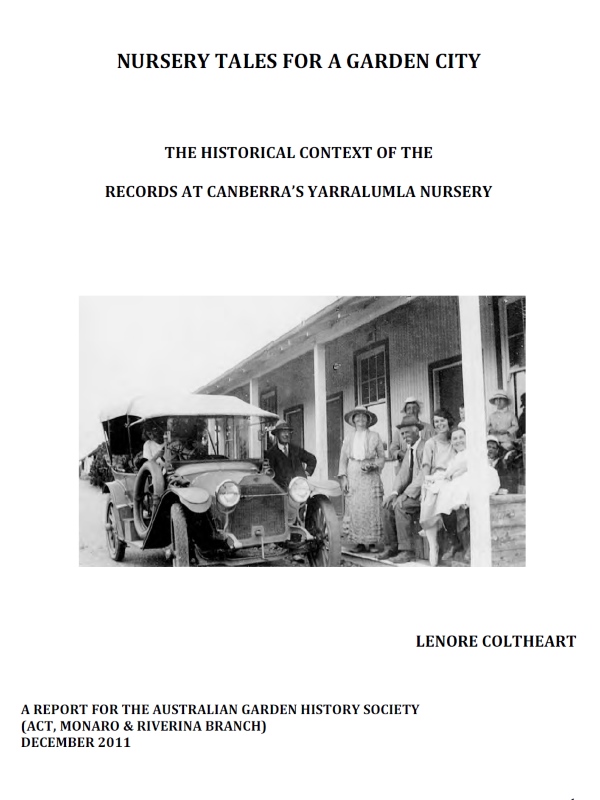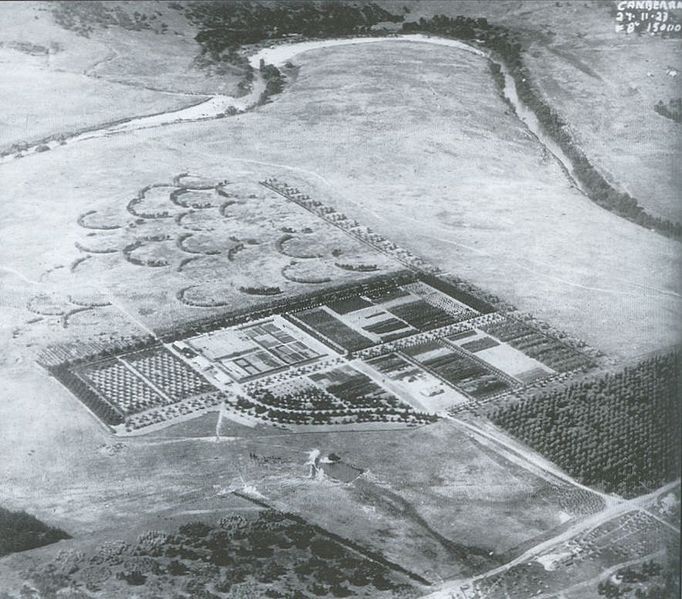Contents
- INTRODUCTION
- THE RECORDS
- PLANT CARDS SET 1
- PLANT CARDS SET 2
- LEDGERS 1-3
- HISTORY
- ORIGINS
- ORGANISATION
- The Weston era 1913-27
- The gap years 1928-44
- The Pryor era 1944-58
- From 1959
- SEEDS & STOCK
- From the region
- From the Griffins
- From the world
- FIRST STEPS
- Shelter
- Food
- Forests
- PLANNING
- Across the city
- Down the years
- PRIVATE POLITICS
- Free for all
- The plant issue scheme
- PUBLIC CEREMONY
- CONCLUSION
- BIBLIOGRAPHY
- APPENDIXES
- CHRONOLOGY
- SOURCES
- REFERENCE PICTURE ALBUM
- INDEX OF TREES
Yarralumla Nursery made the national capital a garden city and also put the bush in the ‘bush capital’. It clothed the landscapes of the Australian Capital Territory and influenced its broader ‘food-bowl’ region. The sketches of this intriguing history given here are drawn from evidence recorded in two groups of handwritten records kept at the Nursery. The records precede the city, they nourished its growth and influenced the wider landscapes of the ACT region. They have been a concealed key to the history of Yarralumla Nursery and of the landscapes and gardens of the national capital. This report shows how digitisation of these records now enables us to unlock a store of tales of the nursery that planted a city.
These records, started by the Nursery’s founder Charles Weston 100 years ago, are mostly handwritten. They are on file cards still consulted and in ledgers still active in daily operations. For this reason the cards and the ledgers, as vulnerable as they are valuable, have remained at the Nursery while other significant records of the first century of Australian government are safe in the custody of the National Archives, or the newer Territory Records Office now responsible for records of the government of the ACT.
The corrugated iron shed housing these records is the same building we see in the background of the iconic images of Nursery head Charles Weston and his nurseryman John Peace Hobday and their families. It was the first Nursery office in 1914 and it serves the same purpose today. The index cards in wooden drawers are the very ones Weston began as a meticulous account of the source, propagation, cultivation, location and trial results of the trees, shrubs, flowers and even pasture grasses the Nursery supplied the city and its countryside. The ledgers are those where thirty years later, Lindsay Pryor began recording the seeds and cuttings he collected around the world – and from the streets and parks Weston had planted.
Of the many issues influencing the selection of a site for Australia’s national capital, horticultural promise was not one. The Limestone Plains were an undulating grassland with few trees, surrounded by lightly wooded hills. Local pastoral estates and farms were garden pockets, marked by trees established as windbreaks. Ninety years of pastoral occupation had shaped the landscapes, but the dominant influence was human and climatic impact over millennia, with a pattern of cold frosty winters and hot dry summers. Wind across the exposed plain and ‘frost hollows’ were added natural handicaps to more extensive tree cover, matched by the introduced problems of rabbits and the practice of clearing trees on hills. In 1911 the landscapes imagined in the winning design for the national capital were far removed from this reality, yet verdant landscape became the chief characteristic of Canberra. The records at Yarralumla Nursery reveal a neglected side of this story, the part science and skill played toward realising the artistic intent.
When Charles Weston saw the site of Canberra in 1911 he knew that collection and analysis of data was essential in meeting its challenges, with precise record-keeping the essential tool. His emphasis on this was recognised by colleagues like head of the Botanical Gardens in Sydney JH Maiden, who reported in 1919:
we are . . dealing with a largely treeless area whose silvicultural conditions, as regards any large number of species, are almost unknown, and data is being laboriously ascertained by the Officer in Charge of Afforestation on the spot. His methods of keeping his records are quite in advance of planting records in Australia, and probably in most other countries’.
The records at Yarralumla Nursery are of importance for botanical scholarship and have a prominent place in investigation of the foundation of the present landscapes of the ACT. They are scientific treasure as well as rich cultural artefact. With their partner documents in government archives, they hold the fascinating stories of people and plants, of pleasures and politics that tell us how a garden city was created. They tell a constitutional tale too, of how an imagined civic landscape was realised from a never ample and sometimes shrivelled public purse.
These plain workaday records are a far remove from Marion Mahony Griffin’s beautiful renderings of Walter Burley Griffin’s design for the layout of the city. Those drawings are rightly considered among our national treasures, their aesthetic appeal the partner of their historic significance. But the records at Yarralumla Nursery, with their associated planting plans and records of plant experimentation, are an essential complement to these drawings.



